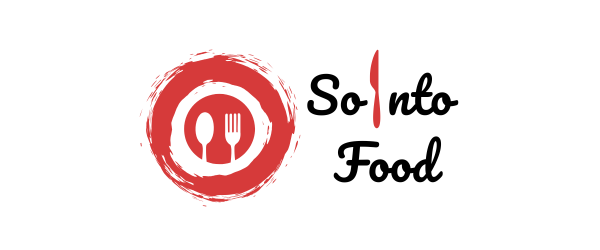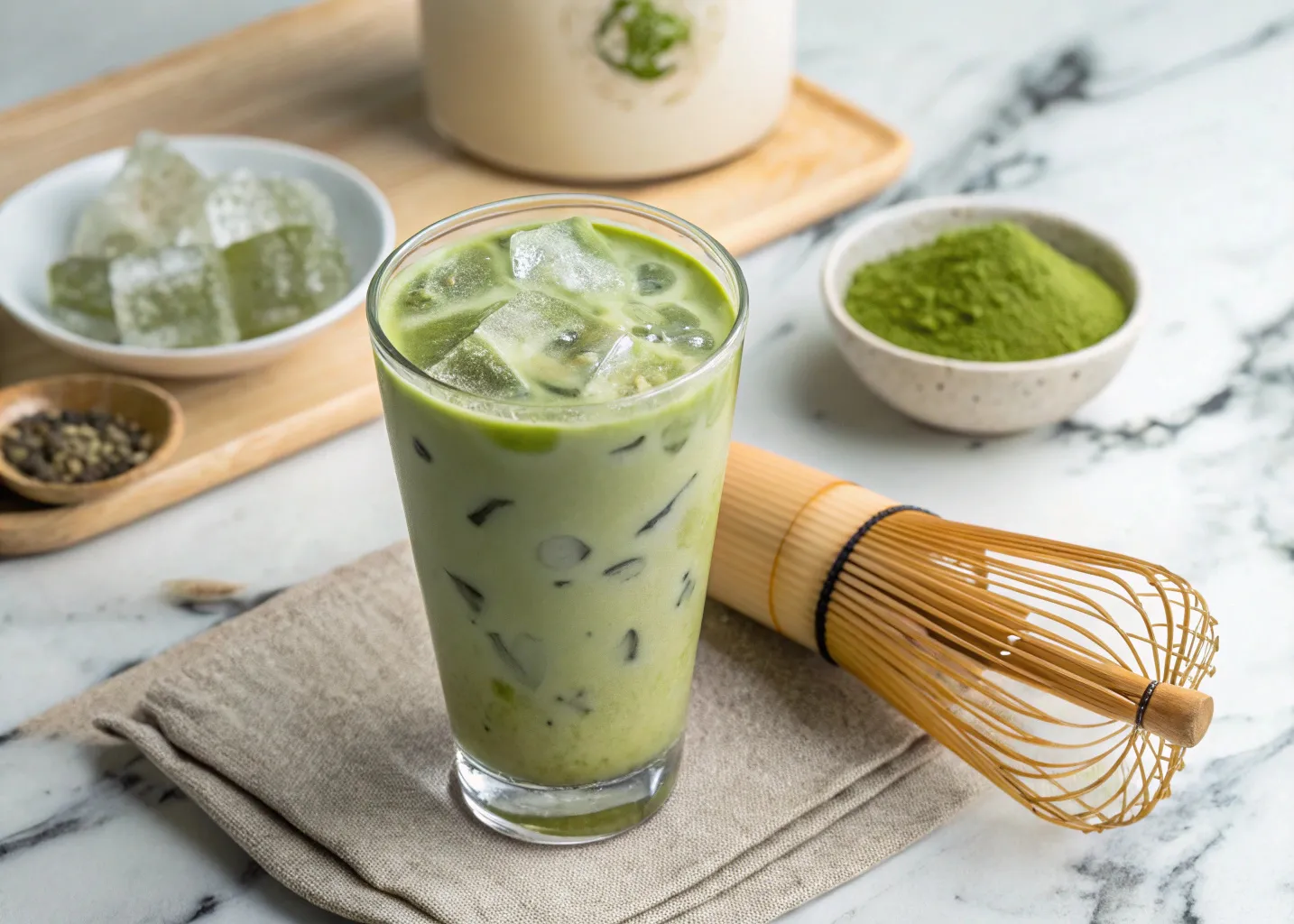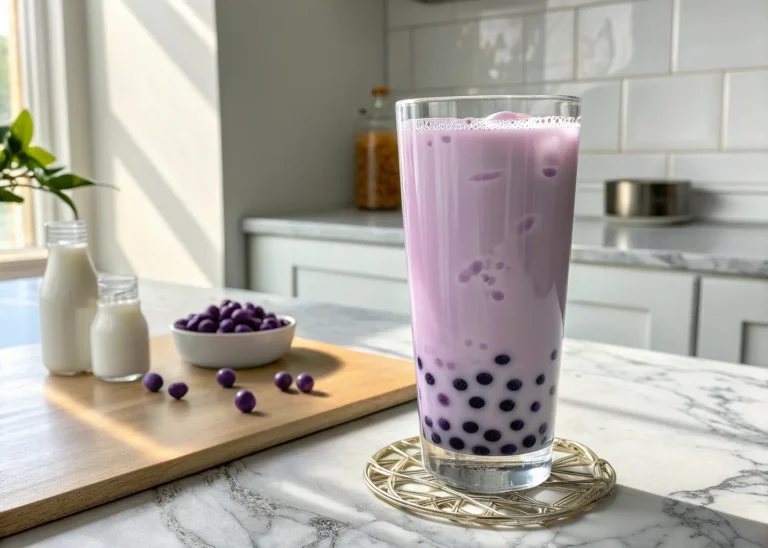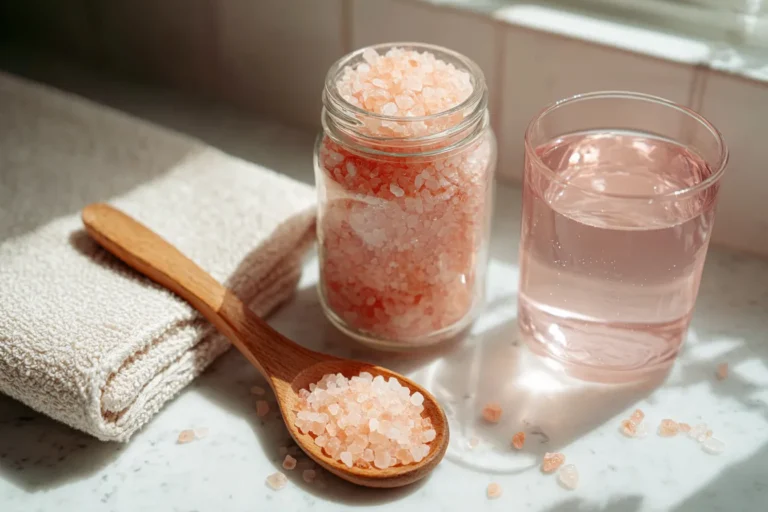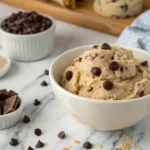Let me tell you—if there’s one drink I never get tired of, it’s an iced matcha latte. There’s just something about that smooth, creamy texture and earthy green tea flavor that hits different, especially on a warm day. Whether you’re looking to switch from your usual iced coffee or just want something a little better for your body, this drink checks every box.
In this guide, I’m going to walk you through everything I’ve learned about making a perfect iced matcha latte at home. We’ll talk about why people love it, what you need, how to avoid rookie mistakes, and even how to customize it like a barista. Trust me—it’s easier than you think, and it tastes better than anything you’ll buy at a chain coffee shop.
Looking for inspiration? Try this refreshing twist like the Brazilian Mounjaro Recipe with Apple Cider Vinegar.
Let’s jump in.
What Is an Iced Matcha Latte and Why Is It So Popular?
What Is Matcha and How Does It Differ From Regular Green Tea?
So here’s the deal—matcha is a type of finely ground green tea powder. It comes from specially grown tea leaves that are shaded before harvest to boost their chlorophyll content. That’s what gives matcha its bright green color and slightly grassy flavor.
Now, unlike regular green tea where you steep the leaves and toss them, with matcha, you’re actually drinking the whole leaf—which means more nutrients and a stronger flavor. And when you turn that into a cold, creamy iced latte? Chef’s kiss.
Why Iced Matcha Latte Became a Favorite Drink Around the World
If you’ve been on TikTok, Instagram, or even just walked past a Starbucks lately, you’ve probably noticed the iced matcha latte boom. It’s everywhere—and honestly, for good reason.
People love it because:
- It’s super refreshing
- It has a gentle caffeine boost without the jitters
- It’s healthier than sugary energy drinks or sodas
- You can totally customize it to your taste (vegan, dairy-free, sugar-free—you name it)
Plus, it just looks cool. That vibrant green color in a glass of ice with creamy milk swirling around? Yeah, it’s got aesthetic AND flavor.
Health Benefits of Iced Matcha Latte (Is It Really Good for You?)
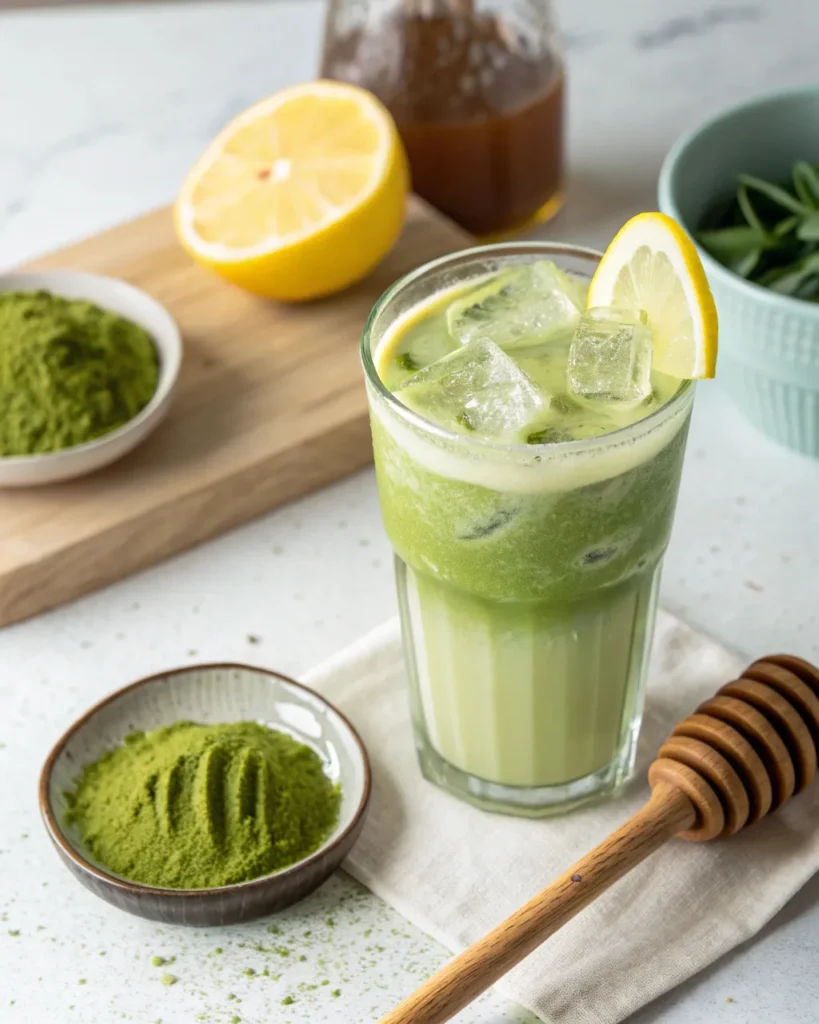
Is Iced Matcha Latte Healthy? Facts Backed by Nutrition
You’ve probably heard people say that matcha is a “superfood,” and I get it—sometimes that word gets thrown around way too much. But when it comes to matcha, the benefits are actually backed by science.
So yes, a good iced matcha latte can be healthy—especially when you make it at home and control what goes in it. Here’s what I love about it:
- Loaded with antioxidants – Especially one called EGCG (epigallocatechin gallate). Fancy name, I know. But it helps fight inflammation and oxidative stress in your body.
- Naturally boosts your energy – It has caffeine, but not too much. Plus, it’s paired with L-theanine, which gives you calm focus without that crash you get from coffee.
- Good for metabolism – Some studies say matcha can help gently increase your metabolism and support fat-burning.
- Gentle on your stomach – Unlike strong coffee, matcha’s less acidic, so it’s easier for most people to sip on.
Now, keep in mind—not all iced matcha lattes are created equal. The ones from coffee chains? Loaded with sugar. But when you make it yourself, you can use healthier sweeteners or skip them entirely.
Antioxidants, L-Theanine, and Caffeine: A Unique Combo
Matcha’s real magic is in its mix of caffeine and L-theanine. Think of it like nature’s way of keeping you sharp without making you jittery. I drink an iced matcha latte mid-morning when I need focus, and honestly, it keeps me dialed in without that post-coffee crash.
L-theanine calms your mind, and caffeine gives it a little kick. Together? You feel alert but not wired. That’s a huge win for me.
Let’s not forget the chlorophyll in matcha either—it helps detox your body naturally and gives that fresh, earthy flavor that sets matcha apart from everything else.
What’s in an Iced Matcha Latte? Ingredients That Matter
Essential Ingredients: Matcha Powder, Milk, Sweetener, Ice
Alright, let’s break it down. When people ask me “What’s actually in an iced matcha latte?”—I tell them it’s simple. You really don’t need a long list of fancy ingredients. Here’s what you need:
- Matcha powder – This is the star of the show. Look for ceremonial grade if you want smoother flavor, or culinary grade if you’re mixing with stronger ingredients.
- Milk or milk alternative – Regular milk works, but I usually go for oat milk or almond milk. They make it extra creamy and keep it dairy-free.
- Sweetener – Totally optional. You can use honey, maple syrup, agave, or go sugar-free with stevia or monk fruit.
- Ice – Don’t skip this. The cold is what makes it that refreshing latte we all love.
If you’re making it at home (and I highly recommend you do), stick to quality matcha. It makes all the difference in taste and color.
And yes—this simple combo can turn into something seriously good with just a little technique. We’ll get into that in the next section.
Types of Matcha: Ceremonial vs Culinary – Which One for Lattes?
Let’s clear up one thing: not all matcha is the same, and the type you choose can either make or break your iced matcha latte.
- Ceremonial Grade Matcha
This is the high-end stuff. It’s meant for drinking on its own, traditionally whisked with just water. It’s smoother, more vibrant, less bitter—and yeah, a bit pricier. If you want a clean, sweet flavor, this is what I recommend. - Culinary Grade Matcha
More affordable and a little bolder in taste. It’s perfect for baking, smoothies, or lattes with add-ins like vanilla or sweeteners. It’s still great—just a bit stronger and slightly more bitter.
If you’re new to matcha, culinary grade works just fine. But once you use ceremonial grade in your homemade iced matcha latte, the difference in flavor is hard to miss.
How to Make Iced Matcha Latte (Step-by-Step Recipe)
Simple 5-Minute Homemade Iced Matcha Latte Recipe
I’ll be honest with you—once I figured out how to make an iced matcha latte at home, I stopped paying $6 at coffee shops. Not only is it way cheaper, but you can tweak it exactly how you like it. Sweet, strong, creamy, dairy-free—it’s all up to you.
Here’s my go-to method. It’s quick, clean, and delivers that coffee-shop quality in just five minutes.
Ingredients:
| Ingredient | Amount |
|---|---|
| Matcha powder | 1–2 tsp (based on how strong you like it) |
| Hot water (not boiling) | 2 tbsp |
| Milk (or alt milk like oat, almond, soy) | 1 cup |
| Ice cubes | As needed |
| Sweetener (optional) | 1–2 tsp of maple syrup, honey, or monk fruit |
Instructions:
- Sift the matcha
Trust me—don’t skip this step. Sifting gets rid of clumps and makes the texture smoother. - Mix matcha with hot water
Use hot water (not boiling—around 175°F / 80°C). Whisk it using a bamboo whisk or a small milk frother until it’s fully dissolved and frothy. - Fill a glass with ice
Just enough to chill everything, but not so much that it waters it down too fast. - Pour in the milk
Cold milk goes over the ice. This is where that creamy base comes in. - Add sweetener (optional)
Stir in honey, maple syrup, or whatever you prefer. Keep it light if you want the matcha to shine. - Top it off with the matcha mixture
Slowly pour the whisked matcha over the milk and ice, letting the green blend into the white—it’s a satisfying swirl to watch. - Stir and sip
That’s it. Give it a little stir, take a sip, and feel like a barista in your own kitchen.
This is your classic iced matcha latte—clean, energizing, and customizable. It’s the kind of drink that feels like self-care in a cup.
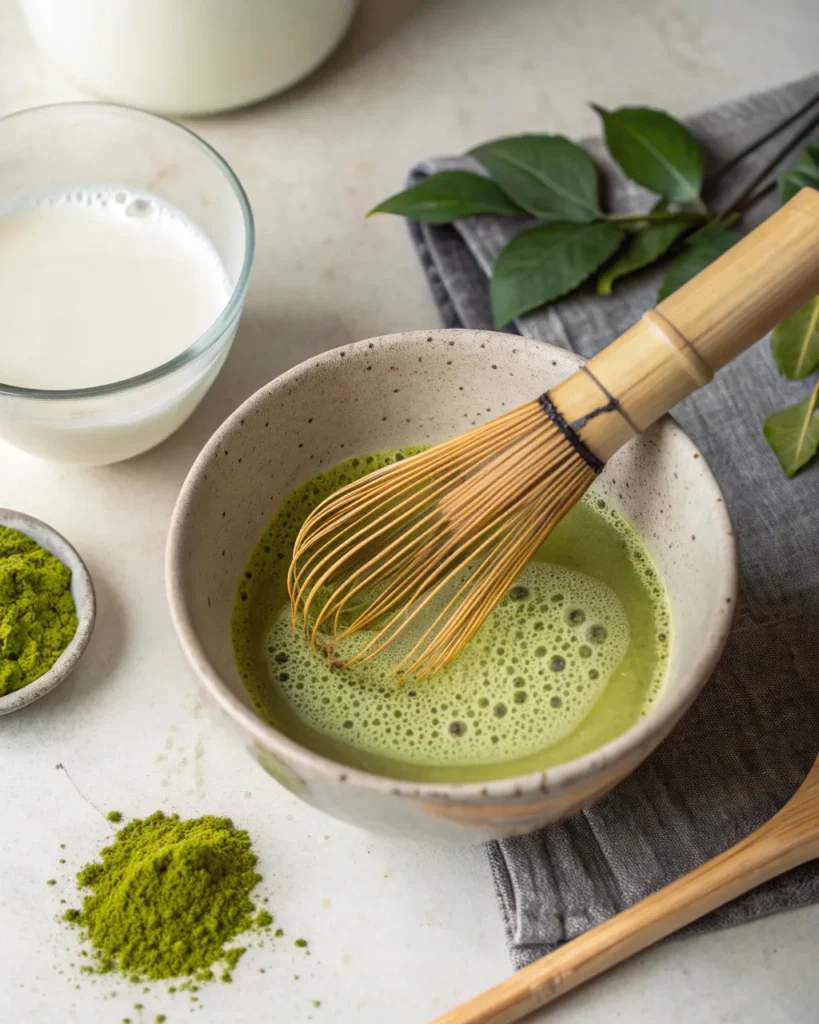
How to Make Iced Matcha Latte Without a Whisk or Frother
Don’t have a fancy bamboo whisk or electric frother? No worries—I’ve been there. You can still whip up a great iced matcha latte without any special tools.
Here’s the hack: use a small jar or shaker bottle.
Just toss the matcha and hot water into the jar, close it tight, and shake like crazy for 30 seconds. Boom—clump-free, frothy matcha. It’s not traditional, but it gets the job done.
You can even shake the whole drink (matcha + milk + sweetener) if you’re in a rush. It won’t look as pretty, but it’ll still taste amazing.
Customizing Your Iced Matcha Latte Like a Barista
Popular Flavors: Vanilla, Coconut, Mint, and Honey Matcha
Look, a basic iced matcha latte is already solid. But if you’re like me and love to play around in the kitchen, then this is where it gets fun. There are so many ways to switch it up and make it feel like a brand-new drink every time.
Here are some of my favorite flavor add-ins that work beautifully with matcha:
- Vanilla: A dash of vanilla extract (or vanilla oat milk) adds that creamy sweetness without overpowering the matcha.
- Coconut: Coconut milk or a splash of coconut syrup gives a tropical vibe—it’s honestly perfect for summer.
- Mint: Add a few fresh mint leaves or a drop of mint extract. It cools things down and pairs surprisingly well with the earthiness of matcha.
- Honey: A tiny bit of raw honey brings out the natural sweetness of matcha and gives you that golden glow kind of taste.
You can mix and match these flavors too. Mint + vanilla? Coconut + honey? Yes, please.
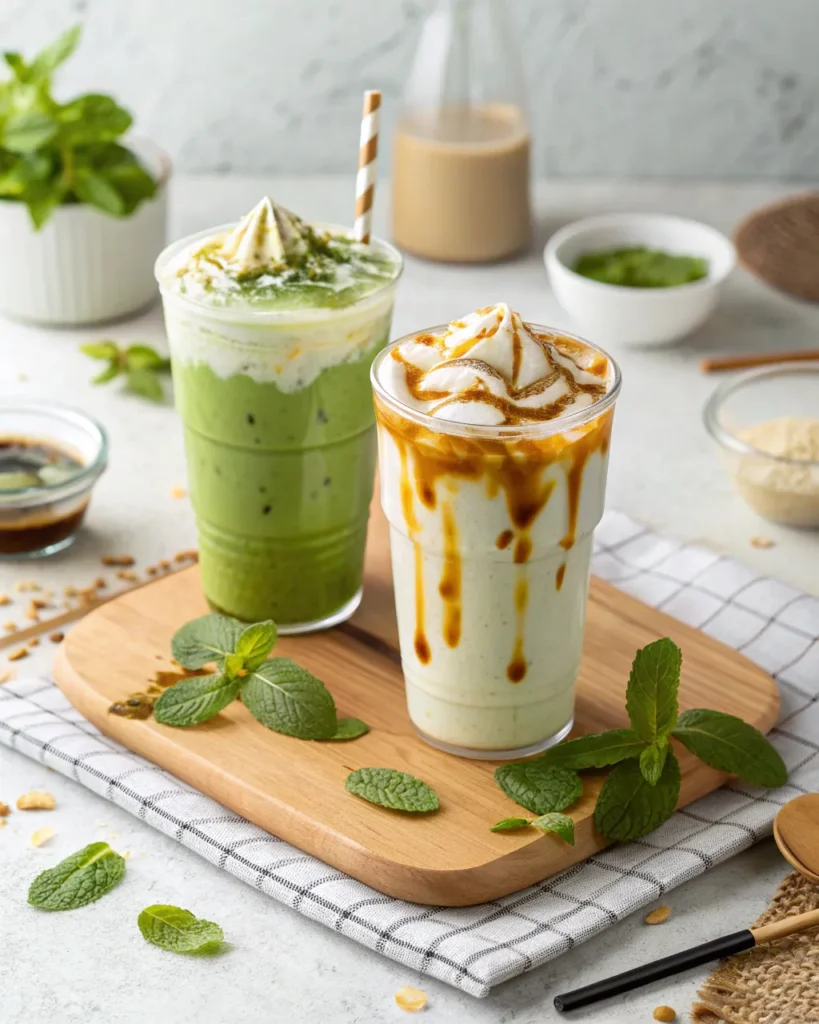
Dairy-Free & Vegan Options: Oat, Almond, Soy, Coconut Milk
If you’re not doing dairy, no worries at all—iced matcha lattes are super easy to make dairy-free or fully vegan. I honestly prefer non-dairy milk most of the time because it just feels lighter and smoother.
Here are a few I’ve tested that work really well:
| Milk Alternative | Texture | Flavor |
|---|---|---|
| Oat Milk | Creamy | Slightly sweet, blends great with matcha |
| Almond Milk | Light | Nutty, clean finish |
| Soy Milk | Medium | Neutral, good balance |
| Coconut Milk | Rich | Sweet and tropical |
Pro tip? If you want that thick, café-style texture, go with barista blend versions. They’re made to froth and mix without separating, especially with ice.
Also, if you’re cutting sugar, skip the sweetened versions. Go unsweetened and then add your own natural sweeteners—maple syrup, agave, or just a little stevia.
The beauty of making your own iced matcha latte is full control. You get to build the flavor, texture, and vibe exactly how you want it—without weird additives or tons of sugar.
How Iced Matcha Latte Compares to Coffee and Other Drinks
Is Matcha Stronger Than Coffee? Caffeine Showdown
Alright, let’s talk caffeine—because that’s usually the first question I get when someone’s switching from coffee to matcha.
So here’s the deal: matcha does have caffeine, but it’s not as much as a strong cup of coffee. A typical serving of matcha (about 1 tsp) has roughly 60–70 mg of caffeine, compared to about 95–120 mg in a cup of coffee.
But here’s where it gets interesting…
Matcha’s caffeine is released slowly over several hours thanks to a compound called L-theanine. That means:
- No sudden energy spike
- No crash later
- Just clean, smooth focus that lasts
Personally, I love that. Coffee gives me a quick jolt, but sometimes I get anxious or jittery. With an iced matcha latte, I stay energized, focused, and honestly… way more balanced.
If you’re sensitive to caffeine or just want a more steady vibe, matcha is 100% the better choice.
Iced Matcha Latte vs Iced Coffee: Which Is Better for Energy and Focus?
Okay, so let’s put them side by side. Iced matcha latte vs iced coffee—who wins? Honestly, it depends on what you’re looking for.
Here’s a quick breakdown:
| Feature | Iced Matcha Latte | Iced Coffee |
|---|---|---|
| Caffeine | 60–70 mg (slow release) | 95–120 mg (fast hit) |
| Energy Effect | Calm focus | Quick energy, short-lived |
| Acidity | Low | High |
| Jitters/Crash | Rare | Common |
| Antioxidants | Very high | Moderate |
| Flavor | Earthy, smooth | Bold, bitter |
So if you need a fast wake-up and don’t mind the jitters, iced coffee works. But if you want long-lasting, clean energy—iced matcha latte is the move.
And here’s the best part: You’re also getting more nutrients with matcha. It’s like energy plus wellness in the same glass.
Common Mistakes to Avoid When Making Iced Matcha Latte
Why Your Matcha Tastes Bitter and How to Fix It
Let’s be real—matcha can taste awful if you don’t make it right. If you’ve ever had a bitter or grassy iced matcha latte that made you go “nope, not for me”, chances are it wasn’t the matcha’s fault. It was the method.
Here’s why your matcha might taste too bitter—and how to fix it fast:
- Using boiling water – Matcha is delicate. If the water’s too hot, it burns the powder and brings out bitterness. The fix? Keep your water around 175°F (80°C) max.
- Using too much matcha – More isn’t always better. One to two teaspoons is plenty. Overloading it makes the taste strong in the wrong way.
- Not whisking it enough – If you don’t blend it fully, you get clumps. And those little bitter bombs ruin the whole drink.
- Cheap, low-grade matcha – If the powder is yellowish or dull green, that’s culinary-grade matcha meant for baking—not lattes. Go for ceremonial grade for a smooth, sweet flavor.
Trust me, once you get the hang of it, the bitterness is gone—and you’ll actually taste how smooth and creamy a well-made iced matcha latte can be.
Avoiding Clumps: Water Temperature, Whisking Tips, and More
Clumps. The one thing that ruins the vibe of any iced matcha latte. You take a sip, and boom—chalky green surprise. Nope.
Here’s how to avoid that:
- Sift the matcha powder first – I know it’s a pain, but it makes a huge difference.
- Use the right water temp – Like I said, not boiling. Warm enough to dissolve the powder but not hot enough to cook it.
- Whisk properly – If you have a bamboo whisk (chasen), use a W motion instead of a circular stir. It froths better and blends faster.
- No whisk? Use a jar or a frother – Toss the powder and water into a mason jar, screw the lid tight, and shake the heck out of it. Easy fix.
The goal is smooth, frothy, and fully blended matcha. Once you get that right, your iced matcha latte will taste like it came straight out of a high-end café.
Where to Buy the Best Matcha Powder for Iced Lattes
Top Matcha Brands for Lattes in the USA
Okay, let’s talk matcha shopping—because not all green powders are created equal. If your iced matcha latte tastes off, it might not be your fault. It could be that the matcha you bought isn’t high quality.
Here are a few top matcha brands I personally recommend (and trust) if you’re in the U.S.:
- Ippodo Tea – They’ve been making matcha in Japan for over 300 years. Their ceremonial grade is next-level.
- Encha – Organic, smooth, and made specifically for lattes. Great for daily use.
- Jade Leaf – Super popular and affordable. Look for their barista edition.
- MatchaBar – Known for café-style blends. Slightly sweet, great if you’re just getting started.
These are all available online and sometimes even in health stores or Whole Foods. When in doubt, start small with a sampler before committing to a bigger bag.
How to Spot High-Quality Matcha (Color, Origin, Texture)
Let me save you some time—and some bad lattes. When you’re shopping for matcha, here’s how to know if it’s good:
- Color matters – Good matcha is bright, vibrant green. If it’s yellowish or dull olive? Skip it.
- Texture – It should feel silky, not gritty or chalky.
- Smell – High-quality matcha has a clean, grassy smell—not fishy or bitter.
- Origin – Look for matcha grown in Japan, especially from regions like Uji, Nishio, or Shizuoka. That’s where the best stuff comes from.
- Label – If it says “ceremonial grade,” it’s likely smoother and better for lattes. If it says “culinary,” it’s meant more for baking.
It might take some trial and error to find your favorite, but once you taste the difference, you’ll never go back.
When and How to Enjoy an Iced Matcha Latte
Best Time of Day to Drink It for Maximum Benefits
So here’s something people don’t talk about enough—when to drink your iced matcha latte.
If you’re drinking it for the benefits (and the vibes), timing makes a difference.
- Mid-morning (around 9–11am) is my go-to. It gives you a clean energy boost right when your body is starting to dip after waking up.
- Early afternoon is another sweet spot—especially if you usually crash around 2 or 3 PM. Matcha helps you stay focused without sending your heart racing like coffee does.
- I wouldn’t recommend it too late in the evening if you’re sensitive to caffeine. Even though it’s a smoother release, it can still keep you awake if you’re sipping it at 8 PM.
Matcha works best when your body needs steady focus and gentle energy, not a slap-in-the-face jolt.
Perfect Food Pairings with Iced Matcha Latte (Light, Healthy Snacks)
You ever sip an iced matcha latte and just feel like something’s missing? Probably food. The good news is: matcha pairs well with a bunch of light, healthy snacks.
Here’s what I like to pair mine with:
- Almond butter toast – The earthy richness of matcha and nutty toast? Yes please.
- Fresh fruit (especially berries or banana) – Adds natural sweetness and balances the matcha’s bold flavor.
- Cottage cheese pancakes – High-protein, low-sugar, and surprisingly perfect with green tea vibes.
- Homemade protein balls – Think oats, nut butter, a little honey… ideal grab-and-go option.
Keep it light—matcha has a delicate flavor. Heavy meals or super greasy foods will drown it out.
The beauty of the iced matcha latte is that you can work it into your day any way you want—as a midday treat, a morning ritual, or a clean energy swap for your usual coffee. Once it becomes part of your routine, you’ll wonder why you didn’t start sooner.
FAQs About Iced Matcha Latte
Is iced matcha latte healthy?
Yes, it can be—especially if you make it at home. Matcha is packed with antioxidants, helps boost energy without the crash, and supports focus thanks to L-theanine. Use clean ingredients, and it’s a smart, refreshing choice.
What does an iced matcha latte have in it?
The basics are easy: matcha powder, water, milk or a plant-based option, ice, and a sweetener if you prefer. You can always elevate it with flavors like vanilla or coconut for a little twist.
Is matcha stronger than coffee?
Not exactly. Matcha has less caffeine than coffee, but it delivers longer-lasting energy because of L-theanine. You get focus without the jitters—and no crash.
What are the downsides of matcha lattes?
The main issue is too much caffeine—if you’re sensitive, it might leave you feeling uneasy. Plus, store-bought versions are often packed with sugar, so making it at home lets you manage exactly what goes in.
Is matcha high in sugar?
Matcha itself has zero sugar. It all depends on how you make it. Some coffee shops load their iced matcha lattes with syrups. At home, you can skip sweeteners or use natural ones like maple syrup or monk fruit.
How to make iced matcha latte at home?
Just whisk matcha with warm water, pour it over ice and milk, and add sweetener if you like. That’s it—easy, quick, and totally customizable.
Conclusion: Why Iced Matcha Latte Deserves a Spot in Your Daily Routine
So, let’s wrap it up—if you haven’t tried making your own iced matcha latte yet, now’s the time. It’s clean, energizing, smooth, and ridiculously easy to make.
You’re in full control of the flavor, the sweetness, the type of milk—everything. Whether you’re trying to ditch your afternoon coffee crash or just want a cool, healthy drink that looks as good as it tastes, iced matcha latte has your back.
Looking for more ways to level up your healthy drinks? Don’t miss our Japanese Pink Salt Recipe for another natural flavor booster.
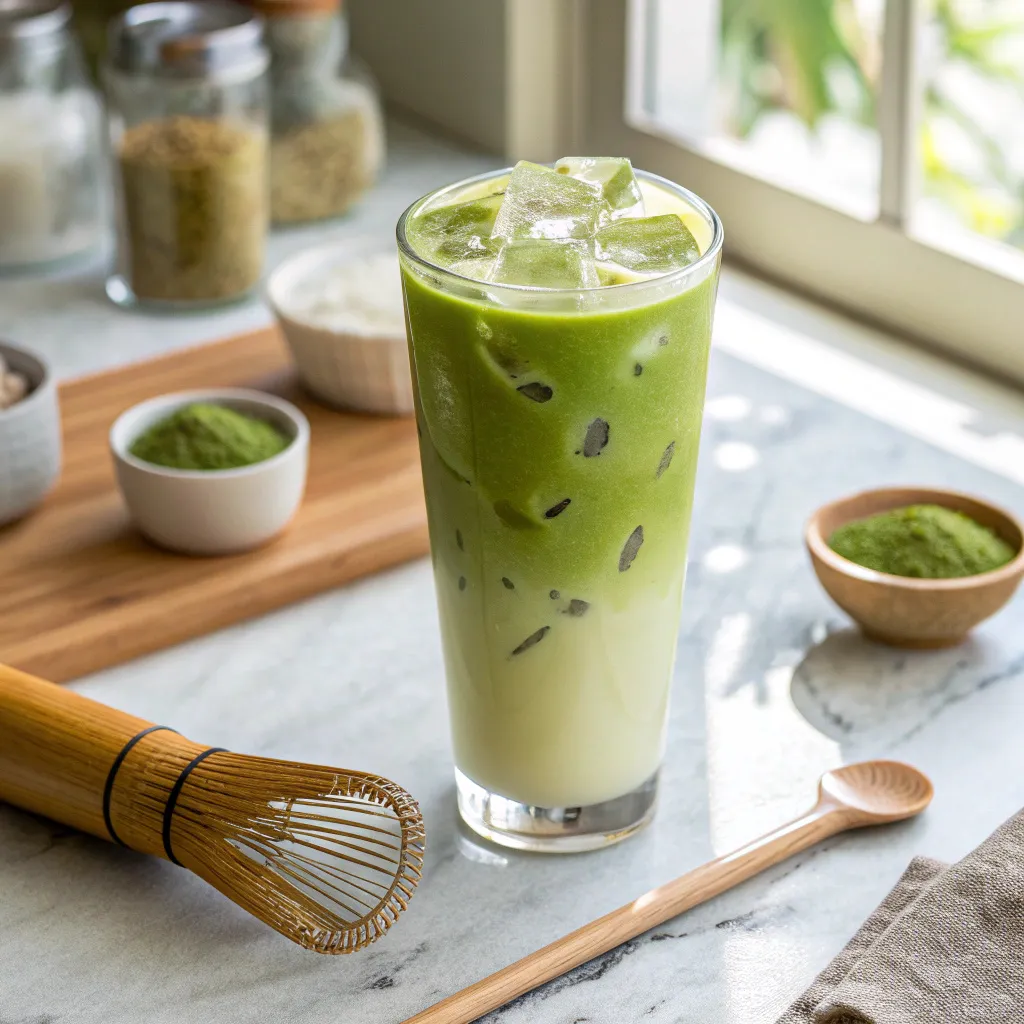
Iced Matcha Latte
Ingredients
Equipment
Method
- Sift the matcha powder into a small bowl to avoid clumps.
- Add warm water (not boiling) and whisk in a zigzag motion until frothy.
- Fill a tall glass with ice cubes and pour in the milk.
- Pour the whisked matcha over the milk and ice, creating a smooth green swirl.
- Add maple syrup or sweetener, if using, and stir gently.
- Enjoy immediately as a refreshing, energizing drink.
Notes
- Use barista-style oat milk for extra creaminess.
- Want a stronger latte? Add up to 2 tsp of matcha powder.
- For a lighter taste, use unsweetened almond milk.
- Avoid boiling water—it makes matcha bitter.
